Core i7 Entry
With the i7 processors at the top of every performance comparison, many readers are interested in building a new Core i7 system. However, much of the i7 architecture is unique compared to current computer architectures, with a new socket 1366 and triple-channel DDR3 memory. That means i7 buyers will likely be buying more components than normal for the move to i7. In fact it is not unreasonable to expect a complete new system build, or at least the bulk of a complete system build, when you decide to move up to Core i7.
The question then is what is the absolute minimum you can spend and still get into a decent performing i7 system? In our System Buyers Guide: $1000 to $2000 a balanced i7 system with the cheapest Core i7 CPU managed to squeeze in at just under $2000. In the short time since that guide was published many prices have dropped, new drivers are available, and there are more options available for a Core i7 system. The goal is also a bit more modest in this Core i7 Entry system. The task was to put together a complete i7 system at near bare bones pricing.
In almost every category a lower performing and lower priced option is possible, but it makes little sense to build an i7 system and saddle it with last generation's midrange video card for example. For that reason the video choice was a Radeon 4870 1GB, which many consider the minimum for a serious gaming rig. Where the lower-priced options make just a small difference in performance we chose lower price, but where it really mattered in total system performance the better performing choice was made.
| Core i7 Entry PC | ||
| Hardware | Component | Price |
| Processor | Intel Core i7 920 Socket 1366 (2.66GHz Quad-core, 4x256KB L2, 8MB L3 Cache) |
$295 |
| Cooling | Intel Retail HSF | - |
| Video | MSI R4870-T2D1G Radeon HD 4870 1GB | $205 |
| Motherboard | GIGABYTE GA-EX58-UD3R X58 | $185 |
| Memory | Patriot Viper 3GB (3x1GB) DDR3-1333 (PC3-10666) PVT33G1333ELK - Retail | $70 |
| Hard Drive | Samsung Spinpoint F1 HD103UJ 1TB | $95 |
| Optical Drive | LG BD/HD DVD / 16x DVD+/- RW GGC-H20LK | $105 |
| Audio | On-Board Audio | - |
| Case | COOLER MASTER Centurion 534 RC-534-SKN2-GP ATX Mid-Tower | $50 |
| Power Supply | OCZ StealthXStream OCZ700SXS 700W SLI Ready CrossFire Ready | $70 |
| Display | Acer H213Hbmid 21.5" 5ms HDMI 1080P LCD - Retail | $190 |
| Speakers | Creative Inspire T6100 76W 5.1 Speakers | $70 |
| Input | Microsoft CA9-00001 Black PS/2 Keyboard and Optical USB/PS2 Mouse - OEM | $16 |
| Operating System | Microsoft Vista Home Premium OEM | $99 |
| Bottom Line | $1450 | |
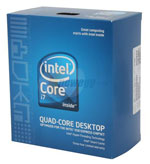 |
The i7 920 is the lowest priced Intel Core i7 you can currently buy. The other two choices are in the $600 to $1000 price range. Don't assume, however, that the 920 is not a powerful processor. The i7 920 is 30% faster in some tests than a Core 2 Quad, and then you find you can also overclock this 2.66GHz CPU to 3.6GHz to 4GHz with careful tweaking and better cooling. You will certainly be very happy with Core i7 base performance, but if you are interested in overclocking you will be even happier with this new CPU.
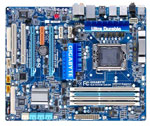 |
The Gigabyte GA-EX58-UD3R has the distinction of being the lowest priced X58 chipset motherboard you can currently buy. Others will join that sub-$200 price point soon to provide more X58 value choices. You probably also noticed that Gigabyte is trying to get as much mileage as possible from their UD3R designation, holding on to a good name as much as possible.
Since this system goal is the lowest priced Core i7 system, we stuck with the retail Intel HSF that comes with the CPU. It works fine with the Core i7 at stock speeds, even though it runs hotter than a similar Intel HSF on Core 2 chips. In the past an Intel retail HSF would be a guarantee of at least midrange overclocking, but the Core i7 runs hotter and you will not get much of an overclock with the Intel HSF. If you plan to overclock you will definitely need a third party HSF, like the Vigor Monsoon III or the Thermalright Ultra-120 eXtreme-1366.
In the Core i7 System in the $1000 to $2000 System Guide, the problems with ATI drivers on Core i7 were discussed. Since then driver releases from ATI are going in the right direction. There is also the price difference, with the capable 4870 1GB some $120 less than the now lower-priced NVIDIA GTX 280. There is also the fact that the Gigabyte GA-EX58-UD3R supports only CrossFire for multiple GPUs.
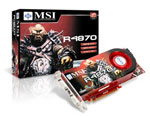 |
Put all those pieces together and the choice for GPU on the i7 Entry system is the Radeon 4870 1 GB. The best value today is the MSI R4870-T2D1G, which is just $205 after a $25 rebate. The best value in HD 4870 1GB cards shifts day-by-day, but you can generally shop for the lowest price on a 4870 1GB card and end up with a good quality card.
 |
Triple-channel memory comes in a 3GB kit (3x1GB) or a 6GB kit (3x2GB). Value dictates the 3GB choice with a great memory package from Patriot. The Viper DDR3-1333 comes as a 3GB kit won't break the bank at $70. For just $70 more, you can upgrade to a 6GB DDR3-1333 kit instead.
Good cases and power supplies are either used forever or they go with the old board on a system upgrade. Generally, it's best to invest in the best case and power supply you can afford. Since this is an Entry i7 we can cut costs on the case and PSU, and with numerous price cuts and rebates available on these components you can still get a lot of value for just a little money.
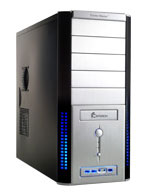 |
The Cooler Master Centurion 534 is a good value no matter how you look at it. It does come in different configurations, and the RC-534-SKN2-GP case is a good choice since it comes with three 120mm fans (front, side, and back) for cooling and installation requires no tools other than a screwdriver for mounting the motherboard. There are also plenty of drive bay options with five external 5.25" bays, one external 3.5", and four internal 3.5". Front USB/Firewire/Audio connectors are also featured. Builders report smooth edges and no sharp pieces to cut your hand during assembly. Even the expansion slots are screwless in this design. Our selection at $50 is black with a brushed aluminum and mesh front, but the case is also available in all black if you prefer at $55.
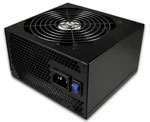 |
The power supply is an excellent value at $70. That $70 buys a 700W OCZ StealthXStream after a $20 rebate. This OCZ PSU specifies an efficiency of greater than 85% with both overload and overvoltage protection. The OCZ StealthXStream 700W should be able to handle whatever you ask of it in powering or overclocking a more basic Core i7 920 system.
 |
Hard drive capacity continues to grow, as you can see in our selection of the Samsung SpinPoint 1TB (1000GB) hard drive at just $95. For less than $100 the value is incredible. While there are differences between hard drives, outside of running benchmarks most people aren't likely to notice the difference in performance between Western Digital, Seagate, Samsung, Hitachi, and other major brands. All are worthy of consideration if the price per gigabyte (or terabyte) is right.
 |
The optical drive for an entry Core i7 system needs to play Blu-ray disks. The flexible LG GGC-H20LK has the ability to read both Blu-ray and HD-DVD format disks. It also can burn DVDs at 16x speed in single or dual-layer formats. It cannot, however, burn 25GB/50GB Blu-ray disks; adding that capability raises the cost to around $200. A BD burner like the LG 6X Blu-ray Burner GGW-H20LK is a good choice if you require a Blu-ray burner.
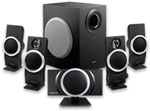 |
After reviewing the current state of onboard audio, we concluded that the onboard solutions are plenty adequate for most of today's computer users. That is why we stuck with the onboard audio on the Gigabyte. Speakers are the 5.1 Creative Inspire T6100 76W system. At $70 the T6100 delivers very good 5.1 surround sound for the price.
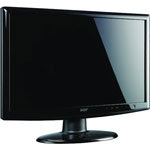 |
The LCD display resolution for the Entry Core i7 system is 1080p full HD (1920x1080). The monitor is one of the new class of 21.5" monitors with a resolution the same as last generation's 24" LCD monitors. The newest monitors use a 16:9 "true HD" ratio instead of last generation's 16:10. The resolution is the same as 24" monitors, but the price is a bargain at $190, which saves at least $100. The Acer H213Hbmid monitor is rated at 5ms and features HDMI inputs for easy hookup to the latest video cards like the MSI Radeon 4870 1GB used in this entry Core i7 system.
By paring components to the items that most affected performance, the bottom line price for a complete Core i7 is cut by more than 25% from our choices of just a few weeks ago. This reduces the price of entry for a complete i7 system to $1450 including a 1080p LCD Monitor, keyboard/mouse, 5.1 speakers, Blu-ray player, 1TB drive, Radeon 4870 1GB graphics, and Windows Vista OS. Performance of this i7 Entry system is definitely in the high-end class, although we will be extending that performance even further in our builds of the Core i7 Overclocking System, and Core i7 Dream system.










106 Comments
View All Comments
greyscale - Thursday, February 5, 2009 - link
"In voltage distribution, we don't see really much difference between the Revolution 85+ and many of the competing units tested this year. The Corsair HX1000W has a very good regulation as well, so the Enermax unit has no advantage in this regard. However, when it comes to efficiency there's not much to compare -- after all, we already said the Revolution 85+ is the most efficient power supply we have tested to date. The HX1000W achieves up to 86% and the Cooler Master UCP is close with up to 89% efficiency."When you factor in the price of the Enermax, it is clearly an inferior product. I feel sorry for people running them.
j@cko - Thursday, February 5, 2009 - link
I feel sorry for you because you are probably too cheap to buy one of those Enermax Revolutions. Money should be no concern for Dream System buyers to begin with. Without regard for cost, Enermax clearly is a better PSU.greyscale - Thursday, February 5, 2009 - link
I actually used to run the Enermax. I swapped it out for the Corsair and I got like, 7 extra FPS in Crysis. It's science, don't shoot the messenger.Corsair > Enermax
j@cko - Thursday, February 5, 2009 - link
LoL... Science? Read the empirically backup benchmarks.whatthehey - Thursday, February 5, 2009 - link
"I actually used to run the Enermax. I swapped it out for the Corsair and I got like, 7 extra FPS in Crysis. It's science, don't shoot the messenger."WTF!? Are you just a complete moron, merely a troll from a competing web site, or are you paid by Corsair? Okay, sure, Anandtech selected the Corsair PSU and it seems liek a fine choice, but seriously, don't give us any bullshit about your PSU making a game run faster.
Since you're just spewing out random garbage with little to no factual evidence, let me join in for a second. I when by greyscale's home and discovered that he is still running an old Athlon XP system in his mother's basement. He hasn't seen any hardware released in the past three years in person (except at a store), and he certainly has never owned, tested, or used a modern Enermax or Corsair PSU.
For that matter, he can't come up with anything other than the old "we need benchmarks for a buyer's guide" comment that we've all seen in the past. RTFW (read the fraggin' website) and you would have a good idea of how the various CPUs perform. There was an article just a week or two back showing overclocked Core i7 performance, but clearly your attention span didn't last that long without a graph.
Would it be nice to see some benchmarks of the systems in this guide? Sure it would. I don't think I've ever seen a buyers guide bother to try and assemble and test the systems, though. That's pretty much putting two or more articles in one, which just means we get less content. I for one enjoy the articles, and the selections look good for what they are - though I wouldn't even think of spending over $2000 on a new system.
"I too can sit around and spec systems on Newegg... You owe me ten minutes."
Great. Let's see your guide, and then we can bitch about it. My bet is it takes more like 10 to 20 hours to research a quality buyers guide, and all you can do is whine about ten minutes. But you know... I read pretty fast and it took me at least 20-30 minutes to actually READ this whole guide. 10 minutes means you probably looked at the tables and then started complaining. Internet anonymity is a godsend, isn't it?
Go back to Tom's (a.k.a. complete sellouts) - we other readers don't want you cluttering up the comments.
7Enigma - Friday, February 6, 2009 - link
Nope, pretty sure there was dry sarcasm there.j@cko - Thursday, February 5, 2009 - link
Well said.whatthehey - Thursday, February 5, 2009 - link
Thanks. Just to point something else out, the motherboard reviews have pretty much shown time and again that the only real difference these days is in BIOS quality, features, and overclocking. A cheaper motherboard might overclock well or it might not... I don't test motherboards, so I'm certainly not qualified to say which is the best. Considering the rant posted here a while back about the state of motherboard releases (http://www.anandtech.com/mb/showdoc.aspx?i=3279)">http://www.anandtech.com/mb/showdoc.aspx?i=3279), I'm inclined to go along with what Anandtech/Gary recommends. I find it interesting that some of the boards that have had major BIOS problems often end up being praised at places like HardOCP and Tom's. It's almost like they purchased a review and editor's choice award - say it isn't so!What was the board a month or so back where the reviewer at HardOCP complained about all sorts of problems and then Kyle came in and said, "it's a great board - here's a silver award!" Must have needed to get more advertising revenue or something. Anyway, I haven't seen anything at Anandtech to make me suspicious of their editorial content. Let's hope it stays that way.
Oh, and don't get me started on the Intel, NVIDIA, etc. bias crap. I've been reading Anandtech for years, and when the Athlon 64 beat the tar out of Intel we read all about it here. When Intel surpassed them, we read all about that as well. Smae goes for NVIDIA and ATI: praise for the 9800 Pro/XT back in the day, slamming the 5800 FX, praising the 6600 GT, complaining about SLI and Crossfire drivers... it all goes in cycles. ATI is doing well with their GPUs, but I would be wary of running more than one ATI GPU in a system. AMD is also doing better with Phenom II, but it's more like catching up with Core 2 Quad than actually beating Intel in any meaningful way.
j@cko - Thursday, February 5, 2009 - link
I was wondering, how come Anandtech did not recommend Enermax Revolution as the PSU for the Dream System? It's got the highest rating among its class everywhere. Thanks.garydale - Thursday, February 5, 2009 - link
OK, so you have to use something to measure value against, but let's face it, these are game machines. That dictated the choice of the OS - Vista - when for other applications you may want Linux, OpenSolaris or something else.I do some video editing, DTP and web development so for me, Linux would make a lot more sense. I get a pure 64-bit OS and 64-bit applications to really take advantage of what the CPU can do. This isn't a huge concern for games which push the GPU more than the CPU, but other applications use the CPU more.
Next, for better disk performance, how about a 3 or 4 disk software RAID array (no need for a hardware RAID adaptor with today's CPUs)? Add some hot-swap adaptors if the case doesn't have them. Just watch read performance go through the roof!
For me, RAID isn't usually a nice-to-have. Video takes up too much space to keep backups of everything. I need the safety of RAID to guard against the inevitable disk failures. And the extra performance is a real bonus.
With respect to speaker, surround sound is great if you are a gamer or trying to challenge Hollywood, but some people prefer stereo for music or just to not have to run wires everywhere. So how about some stereo speaker recommendations?
OK, they're minor quibbles. But there's more to high performance than games.